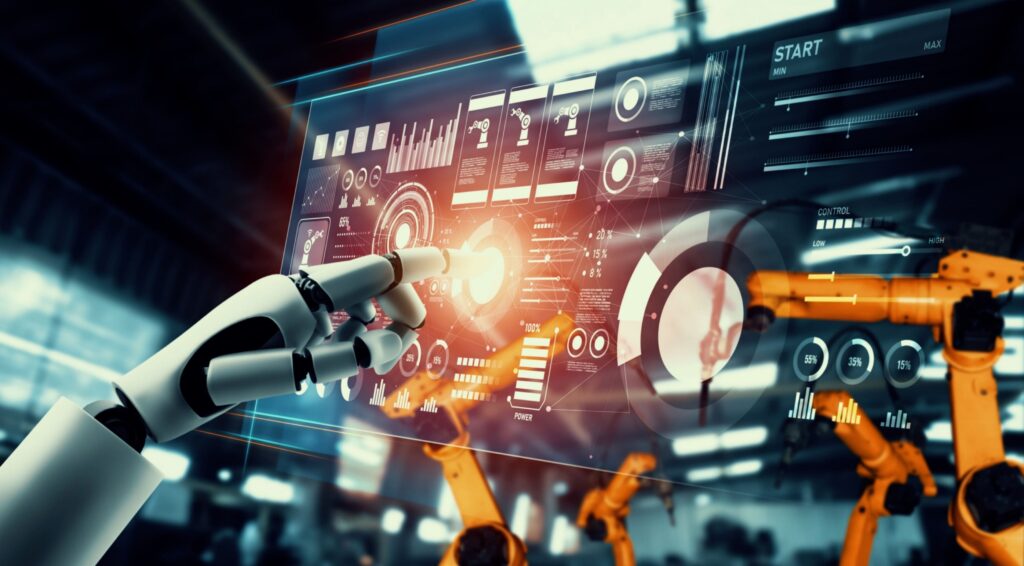Maintenance Automation: Robotics and Automated Inspection Systems
How maintenance automation, robotics, and drone inspection technologies improve asset reliability, lower inspection costs, and make industrial sites safer and smarter.

TL;DR
The next wave of industrial maintenance combines robotics, AI, and automated inspection to perform high-risk and repetitive tasks with unprecedented speed and precision. From drone inspection of pipelines to robotic cleaning and sensor-based monitoring, maintenance automation reshapes how teams maintain safety and uptime. This guide explores real-world use cases, implementation strategies, and the measurable ROI of automated systems.
Highlights
- Autonomous inspection — robotics maintenance and drones capture real-time data from hard-to-reach or hazardous areas
- Process automation — smart algorithms and AI scheduling streamline inspection frequency and maintenance response
- Human-machine collaboration — maintenance automation enhances technician safety and efficiency by shifting focus from routine tasks to high-value decisions
Introduction
When Shell introduced drone inspection and robotic crawlers across its offshore platforms, the impact was immediate. Autonomous drones performed flare-stack inspections that once required scaffolding, cranes, and human climbers — completing the task 90% faster and cutting inspection costs by up to 60%. Meanwhile, magnetic robotic crawlers analyzed corrosion on pipelines and storage tanks without disrupting operations.
Across industries, maintenance automation is redefining how inspection, monitoring, and repair work are executed. Instead of technicians climbing towers or entering confined spaces, robots and drones now handle hazardous or repetitive tasks — while human operators focus on diagnostics and strategy. According to a 2024 MarketsandMarkets report, the industrial inspection robotics market is growing at over 20% annually, driven by advances in AI, autonomy, and sensor miniaturization.
This convergence of robotics, AI, and automated inspection marks a new era of maintenance — one focused on safety, scalability, and data precision. The following sections explore how organizations are implementing robotics maintenance solutions to improve uptime, reduce operational risk, and build the foundation for fully autonomous maintenance systems.
Robots don’t replace maintenance engineers — they extend their reach, accuracy, and safety.
— Dr. Peter Diamandis, Founder, XPRIZE Foundation
The Limits of Manual Inspection and Routine Maintenance
Industrial maintenance has long relied on human skill, but even the most experienced technicians face growing challenges in scale, safety, and precision. Many inspection and monitoring processes remain manual, time-consuming, and reactive — creating inefficiencies that automation can now solve.
The first challenge is safety and accessibility. Assets such as chimneys, wind turbines, or refinery stacks require inspections at dangerous heights or within confined spaces. Manual access involves scaffolding, cranes, and prolonged downtime. Every climb or confined entry introduces measurable risk.
The second issue is frequency and coverage. Manual inspections can’t keep up with the pace of asset degradation. Equipment operating 24/7 — pipelines, conveyors, or storage tanks — demands more frequent checks than human resources can sustain. Missed intervals lead to undetected faults and unplanned downtime.
The third problem is data inconsistency. Visual assessments rely on subjective judgment — two inspectors may report different results for the same defect. Without standardized automated inspection data, trend analysis and predictive maintenance become unreliable.
These limitations create a growing gap between maintenance goals and operational reality. Bridging that gap requires automation — robotics maintenance and drone inspection systems that deliver accurate, consistent, and safe asset data at scale.
Building an Automated Maintenance Ecosystem
Modern maintenance automation combines robotics, AI, and connected data systems to create a continuous inspection and monitoring loop. Instead of performing periodic checks, organizations now gather asset health data in real time — improving uptime, reducing risk, and standardizing results.
- Robotic Inspection Systems
Autonomous and semi-autonomous robots equipped with cameras, ultrasonic probes, and LIDAR sensors conduct visual and non-destructive inspections. Pipeline crawlers and tank-cleaning robots handle hazardous or confined spaces, cutting manual entry by up to 80% and improving safety compliance. - Drone-Based Inspection
Drone inspection platforms perform aerial surveys of flare stacks, cooling towers, solar panels, and power lines. Thermal imaging and AI-driven defect recognition detect corrosion, cracks, and hotspots with accuracy surpassing manual methods. Drones can inspect hundreds of assets per day — with data immediately processed in cloud systems. - AI-Driven Image and Data Analytics
Machine vision algorithms automatically detect anomalies in captured images, reducing human review time. Combined with historical data, AI models predict failure progression, supporting proactive maintenance scheduling and downtime reduction. - Automated Workflows and Reporting
Automated inspection data feeds directly into CMMS or ERP platforms. Reports, maintenance requests, and compliance documentation are generated automatically — ensuring that insights become actions without delay. - Collaborative Human-Robot Workflows
Automation doesn’t eliminate technicians — it enhances their capabilities. Human operators oversee robotic missions, interpret analytics, and make higher-value decisions, improving productivity and precision simultaneously.
Watch: The video AI-supported inspection drone in base maintenance illustrates how AI-supported drones streamline base maintenance inspections, improve defect detection, and reduce manual workload in high-precision environments.
When combined, these systems create a connected maintenance network that scales effortlessly — inspecting more assets in less time, with greater accuracy and lower risk.
Traditional vs Automated Maintenance
The difference between manual and automated maintenance isn’t just about speed — it’s about scope, precision, and safety. Maintenance automation eliminates physical limitations and creates standardized, data-rich inspections that traditional approaches can’t match.
| Aspect | Traditional Maintenance | Automated / Robotic Maintenance | Key Advantage |
| Inspection Method | Manual, visual checks | Automated inspection via robots, drones, and sensors | Continuous, objective data |
| Safety Exposure | Human entry into hazardous zones | Remote and autonomous operations | 80–90% lower safety risk |
| Coverage & Frequency | Limited by human resources | 24/7 operation with no fatigue | Higher data density |
| Accuracy & Consistency | Dependent on inspector experience | AI-driven image recognition and analytics | Standardized, repeatable results |
| Data Integration | Paper or spreadsheet reports | Automatic upload to CMMS / ERP | Instant visibility and traceability |
By shifting from human-dependent to autonomous workflows, organizations can perform inspections 5–10x faster, reduce downtime, and capture high-resolution data for predictive analysis. Automation redefines maintenance from periodic inspection to continuous assurance.
Real Implementation Case
Chevron: Automating Asset Inspection with Robotics and Drones

Challenge: Chevron operates thousands of kilometers of pipelines and offshore platforms requiring constant visual and structural inspections. Traditional methods involved human divers, scaffolding, and rope-access technicians — each posing high risk and cost. A full offshore flare-stack inspection could take two weeks, requiring shutdowns and multiple safety permits.
Approach: Chevron deployed robotic crawlers, aerial drones, and AI-driven defect analytics for automated maintenance. Drones with thermal and LiDAR sensors inspected hard-to-reach areas, while underwater crawlers performed ultrasonic thickness measurements. All inspection data transmitted via satellite to a centralized AI system that automatically flagged corrosion, fatigue, and weld anomalies.


Results: The program reduced inspection time per site by 85% and eliminated 90% of confined-space entries. Unplanned shutdowns decreased by 25%, while overall equipment uptime improved by 18%. Operating costs dropped 22% due to reduced scaffolding and vessel hire. Chevron achieved ROI within 14 months and expanded its automated inspection initiative to all North American facilities.
Key Lesson: Automation delivers the greatest value when it’s integrated into existing maintenance systems, not isolated from them. By connecting robotics maintenance data with CMMS workflows, Chevron transformed inspections from a manual compliance requirement into a predictive, continuous reliability process.

From Manual Inspections to Intelligent Automation
Implementing maintenance automation requires a phased strategy that balances technology adoption with operational readiness. The roadmap below outlines how leading enterprises integrate robotics maintenance and automated inspection into their reliability frameworks.
| Phase | Objective | Key Activities | Deliverables |
| 1. Strategic Assessment | Identify automation opportunities | Evaluate inspection frequency, risk exposure, and ROI potential for target assets | Automation feasibility study |
| 2. Technology Selection | Choose suitable platforms and tools | Test drone inspection models, robotic crawlers, and AI analytics systems; assess compliance and safety standards | Approved technology portfolio |
| 3. Pilot Deployment | Validate performance and integration | Run pilots on pipelines, tanks, or towers; measure data accuracy and efficiency | Pilot performance report |
| 4. System Integration | Connect automation data with CMMS/ERP | Enable automated reporting, defect tracking, and scheduling within existing maintenance systems | Unified inspection dashboard |
| 5. Scale & Continuous Improvement | Expand automation enterprise-wide | Standardize workflows, train teams, and implement analytics-driven optimization loops | Full maintenance automation program |
Organizations following this roadmap typically achieve 25–40% faster inspection cycles, 50–70% reduction in safety exposure, and measurable increases in asset reliability within 12–18 months.
For a technical deep dive into mobile maintenance architectures and real-time inspection systems, this research paper on mobile CMMS and edge analytics outlines how mobile platforms and intelligent gateways enable autonomous maintenance workflows in industrial environments.
Avoiding Automation Implementation Failure
Maintenance automation delivers major efficiency and safety benefits — but only when strategy, data, and human factors align. Many early automation projects fail to scale due to unrealistic expectations, lack of integration, or poor data discipline. Below are the most common pitfalls — and how to avoid them.
1. Overemphasis on Technology, Not Purpose
- Pitfall: Buying robots or drones without defining clear inspection use cases or measurable KPIs.
- Best Practice: Start with high-risk or high-cost inspection areas (flare stacks, offshore assets, storage tanks) and define ROI targets before deployment.
2. Disconnected Data Streams
- Pitfall: Robotic and drone inspection systems store data separately from maintenance records.
- Best Practice: Integrate robotics maintenance data directly into CMMS and reliability analytics dashboards for full traceability.
3. Neglecting Operator Involvement
- Pitfall: Failing to train or involve field teams early, leading to resistance or underutilization.
- Best Practice: Build collaborative human-robot workflows where automation supports — not replaces — technicians.
4. Inconsistent Regulatory Compliance
- Pitfall: Overlooking airspace regulations, data privacy, or safety certifications during implementation.
- Best Practice: Work closely with aviation and safety authorities to standardize procedures and certifications before scaling.
5. Underestimating Data Management
- Pitfall: Storing thousands of inspection images and videos without structured tagging or analysis tools.
- Best Practice: Implement AI-based data management pipelines that automate labeling, defect classification, and historical benchmarking.
Successful maintenance automation projects prioritize integration, training, and governance as much as robotics and AI. The goal isn’t to remove people — it’s to make them smarter, safer, and exponentially more effective.
Key Insights
- Start small, automate smart. Choose inspection areas with measurable ROI and high safety exposure — flare stacks, pipelines, confined spaces. The first maintenance automation pilot must prove time savings and payback within 12–18 months.
- Integration defines scalability. Robots and drone inspection tools deliver value only when their data feeds directly into CMMS or reliability analytics. Standalone pilots create insight silos that stall enterprise adoption.
- Human oversight sustains reliability. Robotics maintenance systems enhance, not replace, human expertise. Skilled operators remain essential to interpret data, approve interventions, and ensure safe, ethical automation practices.
Related Resources
How to Choose a Web Development Company in the USA — and Why the Market Is Evolving Faster Than Ever
Implementing robotics and drone inspection systems requires custom software for data processing, fleet management, and integration with existing maintenance platforms — learn how to select the right development partner.
Industrial IoT Sensors: Complete Guide to Smart Maintenance Infrastructure
Learn how IoT sensors complement robotic inspection systems by providing continuous monitoring data that guides automated maintenance workflows and drone inspection routes.
AI-Powered Predictive Maintenance: Complete Implementation Guide for 2026
Discover how AI algorithms process data from automated inspection systems and robotics to predict failures, optimize inspection schedules, and prioritize maintenance activities.
Conclusion
Maintenance automation marks a decisive shift from manual inspection toward intelligent, connected operations. Drones, crawlers, and robotic systems are no longer futuristic tools — they’re essential components of reliability strategy. By combining AI, autonomy, and human oversight, companies now inspect assets faster, safer, and with greater accuracy than ever before.
The numbers speak clearly: 25–40% shorter inspection cycles, up to 70% lower safety risk, and substantial improvements in uptime and asset longevity. These gains come not from replacing people but from redefining their roles — moving technicians from dangerous, repetitive work into data-driven decision-making.
The next evolution lies in autonomous asset ecosystems: fleets of self-deploying robots, AI-driven analytics, and drones integrated into digital twins. These systems will enable real-time automated inspection and predictive maintenance with minimal human intervention.
The goal isn’t full automation — it’s full assurance. With every mission completed and every defect detected before failure, robotics maintenance turns reliability into a science of precision, safety, and continuous improvement.